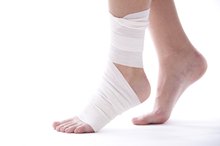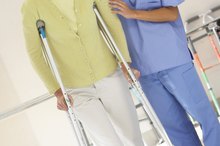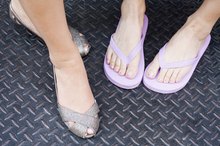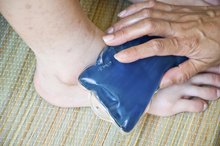Immobilization With Orthopedic Boot Instructions
Orthopedic boots may also be known as walking casts or walking boots. They are used in the treatment of injuries to the lower leg, foot and ankle. Orthopedic boots may be used to immobilize ankle fractures, foot fractures, sprains, stress fractures, tendinitis and other soft tissue injuries. They may also be used to protect the foot and ankle of those recovering from surgery. Orthopedic boots offer mobility and protection at the same time 1. Wearing an orthopedic boot is relatively easy; it just takes a little getting used to.
If you are experiencing serious medical symptoms, seek emergency treatment immediately.
Wear socks that come up to your calf muscle. This can help prevent any irritation as a result of your foot, ankle and lower leg rubbing against the boot. Socks can also help absorb moisture and odor to keep your orthopedic boot fresh.
How to Use a Walking Cast
Learn More
Detach the Velcro straps on your orthopedic boot. Depending on the size and make, orthopedic boots may have between three and five straps.
Place your affected leg in the boot. Position your heel toward the back of the boot. This will be easier if you are sitting down.
How to Tape a Broken Foot
Learn More
Fasten the Velcro straps. The Velcro should be tight enough to prevent your foot and ankle from moving around. However, it should not be tight to the point where it is causing your pain or cutting off your circulation. Begin fastening the Velcro with the straps closest to your toes.
Use a cane, crutches or walker as directed.
Practice walking with your orthopedic boot. Many orthopedic boots have a rounded, rocker-like shape to make walking easier. Wear a tennis shoe or shoe with a small heel on your opposite foot. Orthopedic boots tend to have a sole that is an inch or two thick. A sneaker or low-heeled shoe can help provide for even walking -- which is safer and can reduce the occurrence of pain in your hips and lower back. Practice walking around your house and up and down stairs. For safety, hold onto the railing.
Warnings
If your orthopedic boot is on your right foot, you are not permitted to drive unless you have your doctor's permission to remove the boot.
Related Articles
References
Warnings
- If your orthopedic boot is on your right foot, you are not permitted to drive unless you have your doctor's permission to remove the boot.
Writer Bio
Michelle Zehr started writing professionally in 2009. She has written on health, fitness, fashion, interior design, home decorating,sports and finance for several websites. Zehr possesses a Bachelor of Arts in communication from the University of Pittsburgh, a Master of Arts in professional writing from Chatham University and a graduate certificate in health promotion from California University of Pennsylvania.









